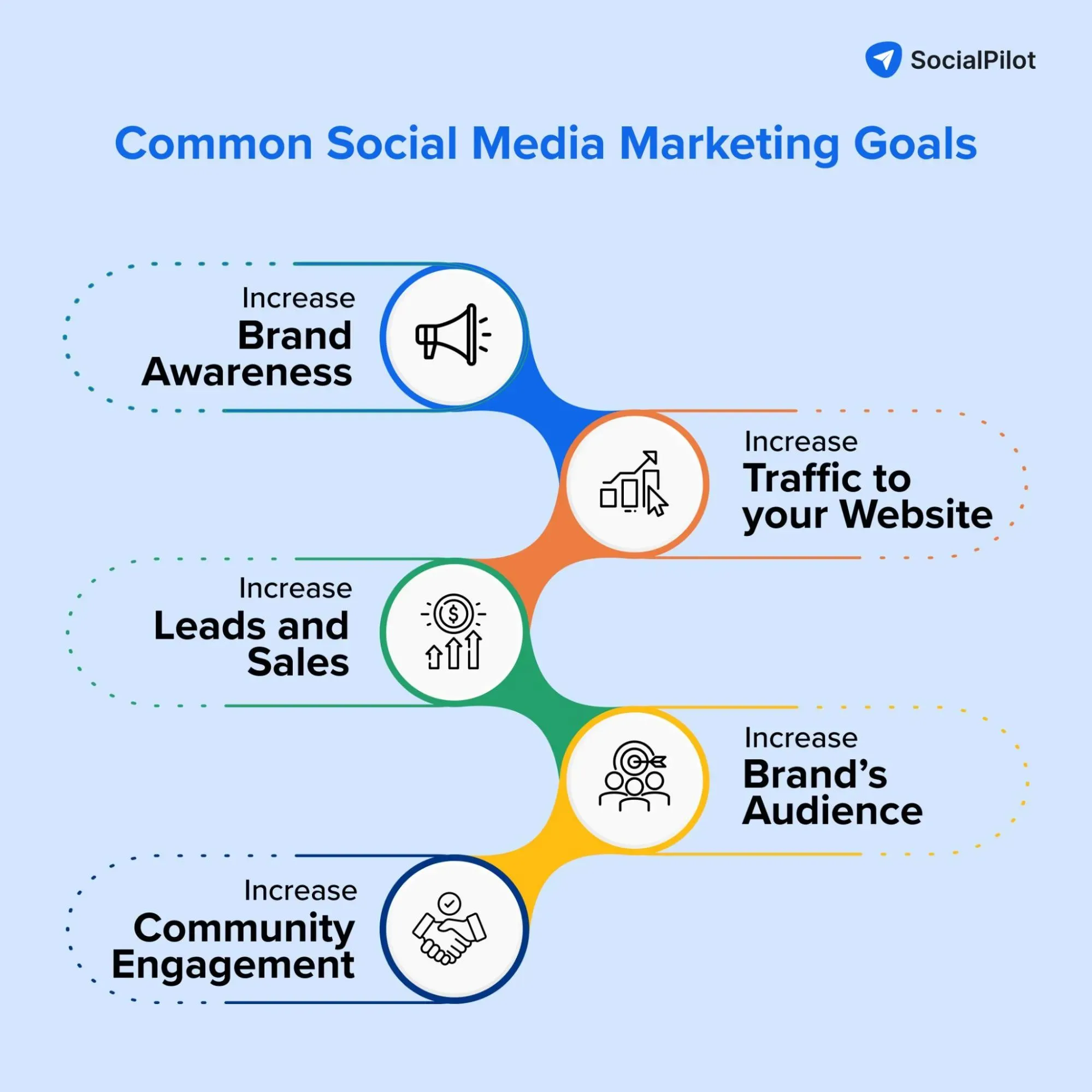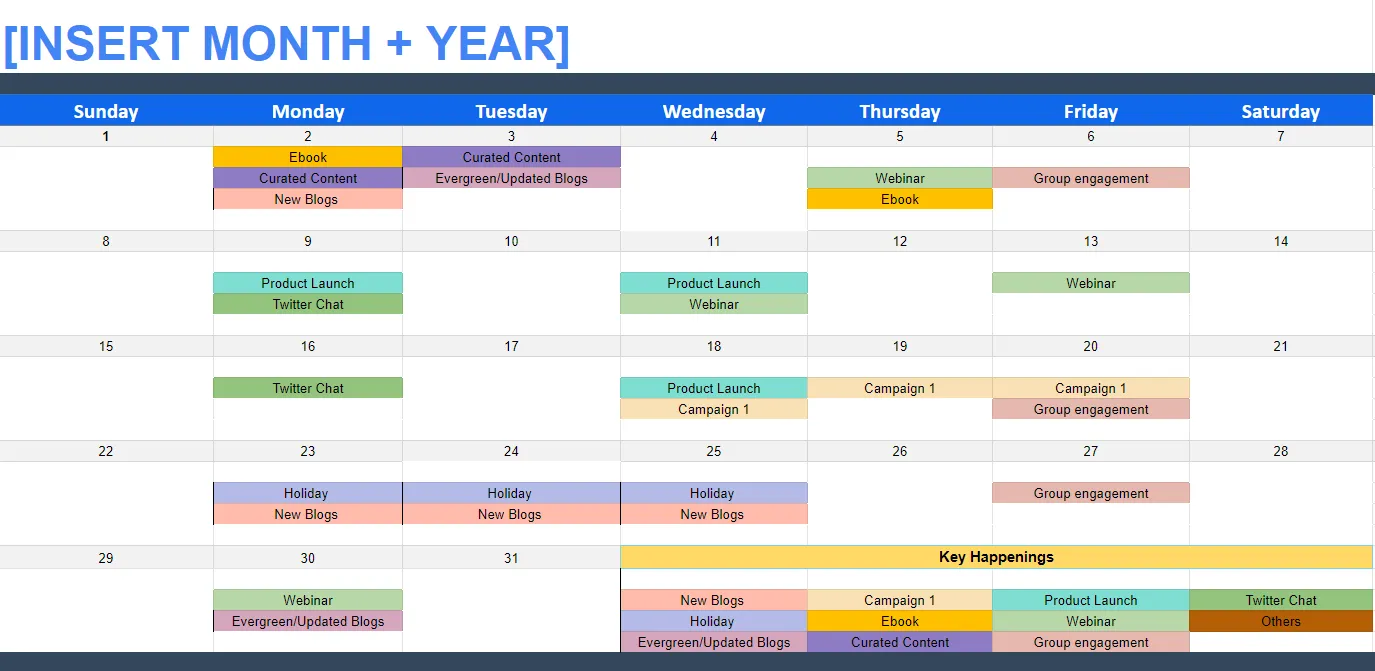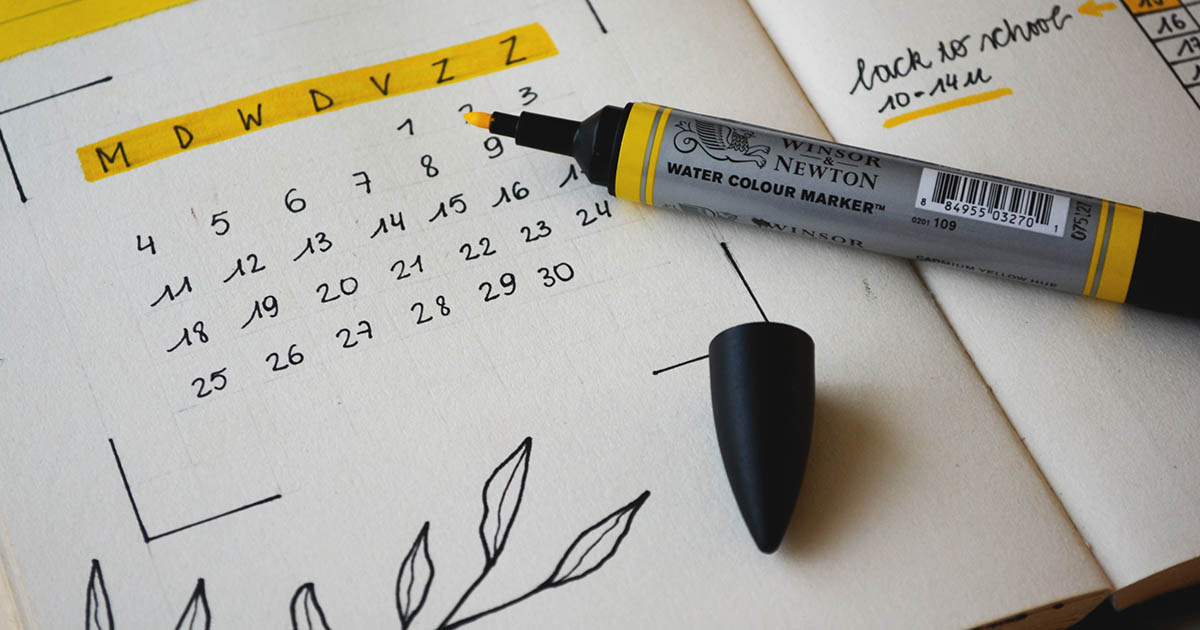As marketers, we have all faced the the chaos of unorganized workflow and unplanned posting, which often jeopardized our brand’s image. A well-designed social media content calendar is the key to evolve from this disarray.
Having a content calendar is useful. It gives you the ability to strategically plan your social media posting plan in advance. However, creating it is another tedious task.
In this blog, you will learn how to create a content calendar. We will also share a free social media calendar template to start you on the right foot with a consistent and well-planned schedule.
That’s not it.
We will also discover the best tools for organizing your weeks and months of content and some common social media calendar mistakes to look out for while planning.
What Is a Social Media Content Calendar?
A social media content calendar is a detailed overview of your posting schedule on all social channels by date and time. Marketers use it as their social planner to manage what they’ll post, where they’ll post, and when it will go live.
A content calendar offers a systematic approach for following deadlines, taking approval, maintaining consistency, and analyzing performance. A simple calendar contains dates, times, content, media, links, specific events, etc, according to the campaign and social network.
You can create a social media calendar based on your scheduling and posting needs with a ready-to-use template or social media calendar tools (more on both below), which offers an intuitive calendar that auto-fills.
Why Do You Need a Social Media Content Calendar?
Having a social media planner calendar is more than just ensuring posting at the right time; it is about effective management that leads to spending more time on impactful content creation.
Creating a calendar is like self-care. You no longer have to feel the terror of coming up with the content idea right before it’s time to get down to work and write your next post, as the deadline is looming on the horizon.
Some of the primary benefits of maintaining a social media planning calendar include:
To Stay Organized and on Track
Scribbling your content topics on crumpled pieces of paper, post-it notes, and in random notebooks isn’t a particularly reliable method. Also, it’s likely to drive you away from what’s really important amid so many ideas and things to think about.
When you have a social media content calendar, you can lay out your topic ideas and assign them to different categories and campaigns. This structured approach ensures that your content remains focused and aligned with your broader objectives. Besides, it will help you mend content gaps and prevent you from missing your content’s deadline.
To Help You Stay Consistent
The 3 Cs of content marketing might as well be consistency, consistency, and consistency. The key to always being on your audience’s radar is offering them educational, relevant, and entertaining content day after day.
Irregular posting leads to an out-of-sight-out-of-mind kind of scenario, no matter how much your audience likes your efforts. You can use a social media calendar tool to keep things in check.
To Keep Your Audience Engaged
Sometimes, you can indeed wing it, but that’s not a method that will work in the long run. When you’re hurrying to publish something, you might fail to check if it’s a repetitive topic covered beforehand.
Similarly, randomly picked topics that don’t resonate with your target audience can hurt your engagement. However, an organized social media content calendar will allow you to spot such potential missteps so you only publish fresh and relevant content.
To Keep Track of Your Performance
Tracking your metrics is the only way to measure the effectiveness and success of your content and overall marketing efforts.
When your calendar already has all the published posts, adding the key metrics associated with each post there just makes complete sense. It gives overview of your top-performing content that resonated best with your audience. By monitoring these numbers, you can tweak and fine-tune your content and give your audience what they need and want.
To Ensures Better Team Collaboration
A social media calendar is not just for one person; it’s for the team, too. You can collaborate with your team members, assign them tasks based on priority, and make the workflow systematic.
Everyone can access your content plan and participate in the planning and execution with a centralized view. This is also useful in minimizing back-and-forth communications for approval from clients or stakeholders about content.
An organized and well-planned social media content calendar streamlines all this. It simplifies your entire marketing strategy and keeps you aligned with the result. Do you want to know how to create a social media calendar and schedule social media posts? Follow these six easy steps to create your own.
How to Create a Social Media Content Calendar?
Making social media calendars can be intimidating, but once you get a hold of it, your marketing strategy will become more powerful and intend-oriented.
So, let’s begin breaking down each step to create your personalized calendar:
1. Audit Your Current Social Media Posts
Everything starts with a detailed social media audit. This will determine whether your existing content and identity resonate with the target audience and help you determine gaps and opportunities to include in your calendar.
Look at the metrics, such as reach, likes, shares, comments, saves, etc, of each type of content (e.g., images, blogs, videos, reels, stories).
To analyze your current social media presence, you can follow the below procedure:
- Compile All Your Social Profiles: Gather all the social profiles in one place to conduct the audit and comparison. Make sure they are all active and optimized.
- Identify Weaknesses: Keep an eye out for the profile or content that does not fit your identity or has performed badly, and find out why it has not engaged enough.
- Establish Your Social Media Goals: Define your future goals. Having a clear social media goal based on your desired campaign’s expectations is necessary to streamline the process.

- Identify Your KPIs: With a clear goal, you can pinpoint the KPIs, such as engagement, CTR, conversions, brand awareness, etc.
- Identify Your Top-Performing Social Content: Based on the set KPIs, you can identify the content that has helped you reach your social media goals. Such type of content will re-appear in your new calendar.
- Determine Your Social Media ROI: After analyzing the content, multiple social media accounts, and goals, the final tone is set by the ROI. Calculate your current ROI and set the future expectations and based on that plan your calendar.
You can follow the above process or use our free social media audit template, to streamline the analysis of your current social media channels.
2. Choose Social Media Channels and Set Content Theme
Every social media platform has a different tone and vibe. Not every platform is a perfect fit for your type of content. For instance, Instagram and Snapchat are great for visually-driven content, while LinkedIn suits more textual, professional content.
You need to choose the platform where you are most likely to find your target audience. Consider your audit and pick the platform most effective for your brand.
After that, set a clear theme for your content based on your brand goals and audience interests. For example, if you are a fitness brand, your theme can revolve around fitness routines, nutrition tips, customer spotlights, etc.
Once your platform and theme are finalized, you can find engaging social media post ideas and fill your social media content calendar.
However, you also need to ensure a content mix, which is distributing different content types (informative, promotional, UGC, etc) on your calendar. For this, you can follow different strategies:
The 80-20 Rule
- 80% of your content should be informative, educational, and entertaining.
- 20% of your content should be to promote your product and brand.
Like SocialPilot’s Instagram account, which has a perfect mix of informative social media updates, entertaining memes, and promotional content.

The Social Media Rule of Thirds
- ⅓ of content from followers
- ⅓ of content to promote your product
- ⅓ of content should be interaction with followers
While following any rule rememeber that even when you are not directly promoting your product, ensure to stick to your niche and resonate with your social media style guidelines.
3. Choose the Right Tools and Templates
Now that you have all the necessary items, you can start mapping them onto your social media editorial calendar. But before that, you need to decide whether you want to create a social media calendar from scratch, use a tool with an auto-fill calendar feature, or utilize a ready-to-use template.
The resource selection for your social media calendar should be based on your specific needs. If you’re looking for a basic calendar to jot down a few details, building it from scratch might suffice. Alternatively, opting for a free, customizable calendar templates could be the ideal solution.
However, if you want advanced features like scheduling capabilities, multi-platform posting, and analytics tracking, you should consider utilizing dedicated social media calendar tool like SocialPilot.
For any of the above, you need certain elements to prepare your content.
- Daye, Date, and time
- Holidays
- Post content copy
- Post caption
- Post Format
- Social Platform
- Visual assets
- Post Status
- Tracking links (if any)
Decide on these factors and use them to make a content calendar. Below is an example of a weekly calendar social media calendar, illustrating how these factors can be organized.

4. Plan, Create, and Schedule Posts
With your theme, platforms, content types, and tools in place, it’s time to start planning your actual content.
When populating your social media content calendar, evenly distribute different formats (text, images, videos) throughout your schedule and leave room for timely posts related to events, holidays, current affairs, news updates, and other relevant happenings.
Plan your social media content calendar around your campaign , incorporating a variety of content to keep your target audience consistently engaged. Develop posts that match the platform, your theme, and your goals. Below is a peek into how you can segment your content format and for which platform it is planned.

The whole purpose of a content calendar is to keep your social media strategy organized, so prepare batches of content in advance and schedule it for the best time to post to get the highest engagement.
5. Collaborate with Teammates and Clients
If you are creating a social media schedule and working on it alone, you are doing it wrong. Social media is not a one-person job; it requires teamwork.
For the actual content, captions, and post copy, you can collaborate with your teammates and assign tasks to generate fresh ideas, schedule social media posts, etc.
When you have a calendar for your social media plan, your content is pre-made and can be sent to teammates, clients, and stakeholders for approval and collaboration. This way, you can ensure that every piece of content is of the highest quality, free from errors, approved, and perfectly aligned with your brand’s tone.
6. Track and Analyze Your Social Media Content Calendar
Your work doesn’t end at just planning a social media content calendar. The next step is to keep track of your content performance and analyze the results.
Consistently monitor the KPIs to analyze which of your posts are doing well and which ones are not reaching the mark. Doing this will help you optimize your existing calendar and better plan future calendars. At this stage, using analytics and reporting features tools help you effectively track your performance based on the goals you set.
Free Social Media Calendar Templates
We have created a free customizable template to help you create a useful social media content calendar. This well-crafted template will keep you organized and consistent in reaching your goals.
This is a monthly view of the social media editorial calendar. As you change the month, the view also shifts according to the dates and days. The monthly layout allows you to plan the publishing of different content themes across various dates.

In the next tab, you can further break down your calendar by channel, where you can include the following details for each social platform:
- Day
- Date
- Time
- Post Content Type
- Post Format Post
- Description
- Post Creative
- URL
- Campaign Name
- UTM
- Goal
This is designed to last long and do the heavy lifting for your social media schedule. You just have to download the template from the below link, change the month and year as prefered, and start planning.
Here’s a free social media calendar template for you to get started:
If you want a more robust solution than a spreadsheet that goes beyond planning, move your focus to using calendar tools.
Choose the Best Social Media Calendar Tool in 2024
For efficient content management, it is essential to select the right social media calendar tool. There are a variety of options available, but it’s important to know how each tool compares in terms of key features necessary for planning and execution.
Here’s a comparative representation of the five tools against critical functionalities to help you identify the best tool to meet your specific needs.
|
Buffer |
Hootsuite |
SproutSocial |
SocialPilot |
|
|---|---|---|---|---|
| Unlimited Scheduling | ||||
| Customizable Daily, Weekly, Monthly View | ||||
| Drag and Drop to Any Time Slot | ||||
| Preview Scheduled Posts | ||||
| Schedule for Multiple Accounts | ||||
| Delete Published Posts | ||||
| Collaborate with Team on Drafts | ||||
| Collaborative Notes | ||||
| Schedule Drafts by Date | ||||
| Holiday and Special Day Indication | ||||
| Know Content Status | ||||
| Indication of Best Time | ||||
| Quick Clarity of Post Type | ||||
| Post Tagging | ||||
| Sharable Calendar | ||||
| Post Approval Workflow | ||||
| Reshare Existing Posts | ||||
| Event and Campaign Planning | ||||
| Advanced Search and Filter | ||||
| Color-coded Calendar Notes | ||||
| Historical View of Posted Content | ||||
| Identify Target Audience | ||||
| Minimum Pricing | $120/Month | $149/Month | $249/Month | $30/Month |
5 Top Social Media Calendar Mistakes to Avoid
As you start planning your social media calendar, there are several things you need to take care of to avoid potential mistakes that can hinder your success. Let’s discuss some common pitfalls and solutions to avoid them:
1. Not Tailoring Content for Each Social Media Platform
Every social media platform caters to a unique audience and content type. For example, LinkedIn is known for its professional content, and TikTok is all about short entertaining videos.
Now imagine what will happen if you share professional achievements on TikTok and a short entertaining video on LinkedIn. Your engagement will fall flat for sharing irrelevant content because the audience on these platforms is not looking for that type of content.
Not following the versatility of every social channel can result in low visibility and reach. Sharing the same content type on each platform will not help you reach the goals, even if you are consistent. That’s why planning your calendar considering the different voices and vibes of each platform is necessary.
2. Not Repurposing Evergreen Content
Evergreen content stays relevant and valuable for years, and repurposing such content can attract engagement.
First, you must identify the evergreen content that has generated outstanding engagement and reach for you in the past. These types of content aren’t necessarily promotional; you can even repurpose educational or entertaining content like memes.
After identification, you have to decide if it needs repurposing or if it can be shared as it is at a later date. Repurposing popular content into a new format can extend its lifecycle and prevent it from gathering dust over time.
3. Not Segregating Monthly and Weekly Calendars
Whether you make a social media content calendar from scratch, use a template, or utilize a calendar tool, you need to figure out a way to segregate your monthly and weekly content plan. Blending both schedules can create confusion and overlap.
The monthly content calendar is primarily for planning the overarching themes, campaigns, and major events. However, the weekly content plan breaks down each post with a date and time for posting. Combining these two can prevent you from distinguishing between the monthly theme and weekly detailed scheduling.
Using tools that let you visualize monthly and weekly content separately is necessary. SociaPilot has an intuitive content calendar that provides a single UI view of both types of calendar schedules for better understanding.
4. Not Having a Consistent Posting Frequency
While a social planner calendar has several benefits, posting consistency is the most important one. Often, Marketers make the mistake of not being consistent in their posting. If they have a regular frequency of one platform, it lacks on the other.
Not having consistent content distribution throughout the calendar might slow you down in reaching your goals. Sharing good quality content regularly is crucial, as your audience relies on it for brand updates, or else they might lose interest.
While you create your content calendar, keep the content moving to keep your audience engaged. Establishing and maintaining a consistent posting frequency is how you can make the best use of your content calendar.
5. Not Re-evaluating and Optimizing
Having a social media calendar and sharing content consistently is not enough. You must regularly revisit your content’s performance and evaluate how it’s changing to evolve your social media strategy.
To effectively monitor your performance across multiple platforms, you need a social media management tool that offers multi-platform analytics and shares insights on the regular changes in your reach and engagement.
This is where SocialPilot comes in. With its analytics and reporting feature, you can regularly re-evaluate and optimize your strategy and adapt based on real-time data. This is how you can refine your business growth according to your audience feedback and market trends to ensure your strategy remains relevant.
By avoiding these mistakes, you’ll save time and enhance your brand presence on social media. To never face low reach, this is how you can make your social media efforts a powerful component of your marketing strategy.
Reflecting Back
Having a content calendar isn’t just about organizing your content in one place; it’s about creating a social media plan that drives you to leave a lasting impact on your brand’s social media presence.
Your calendar will ensure that you maintain a consistent posting schedule, align your content with broader marketing goals, and engage your audience effectively across different platforms.
Scrambling for content ideas at the last minute is old news; creating a social media content calendar and scheduling content in advance is the key to precision.
Start with spreadsheet calendars, but don’t stop there. Go above and beyond with SocialPilot, which not only enables you to plan your posting schedules across multiple channels but also gives you the option to schedule them for publishing.
Try SocialPilot for FREE!





